Business Law Assignment
VerifiedAdded on 2022/11/29
|9
|1814
|384
AI Summary
This is an individual assignment on Business Law. It includes questions and answers related to contract law, tort law, and corporate law.
Contribute Materials
Your contribution can guide someone’s learning journey. Share your
documents today.
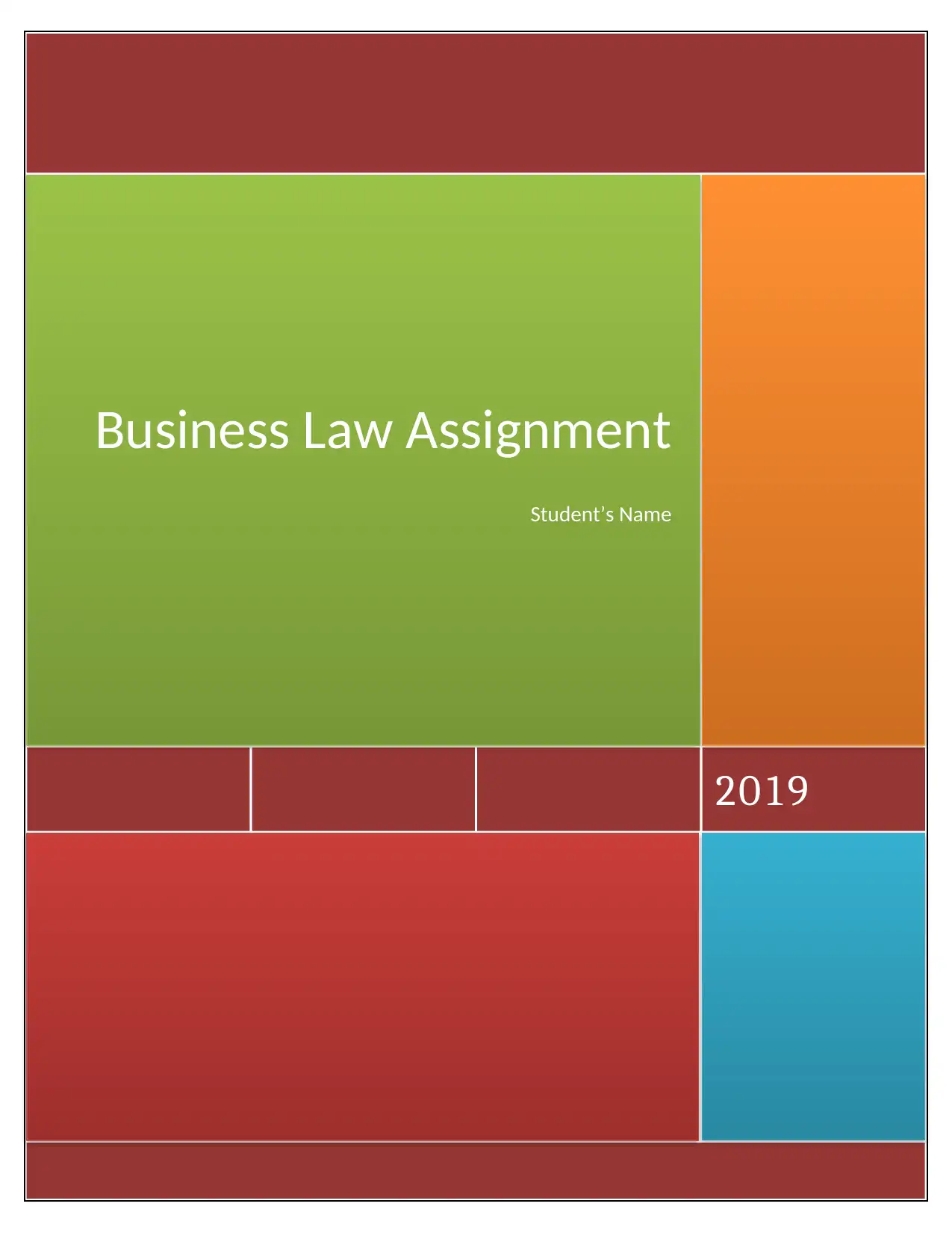
2019
Business Law Assignment
Student’s Name
Business Law Assignment
Student’s Name
Secure Best Marks with AI Grader
Need help grading? Try our AI Grader for instant feedback on your assignments.
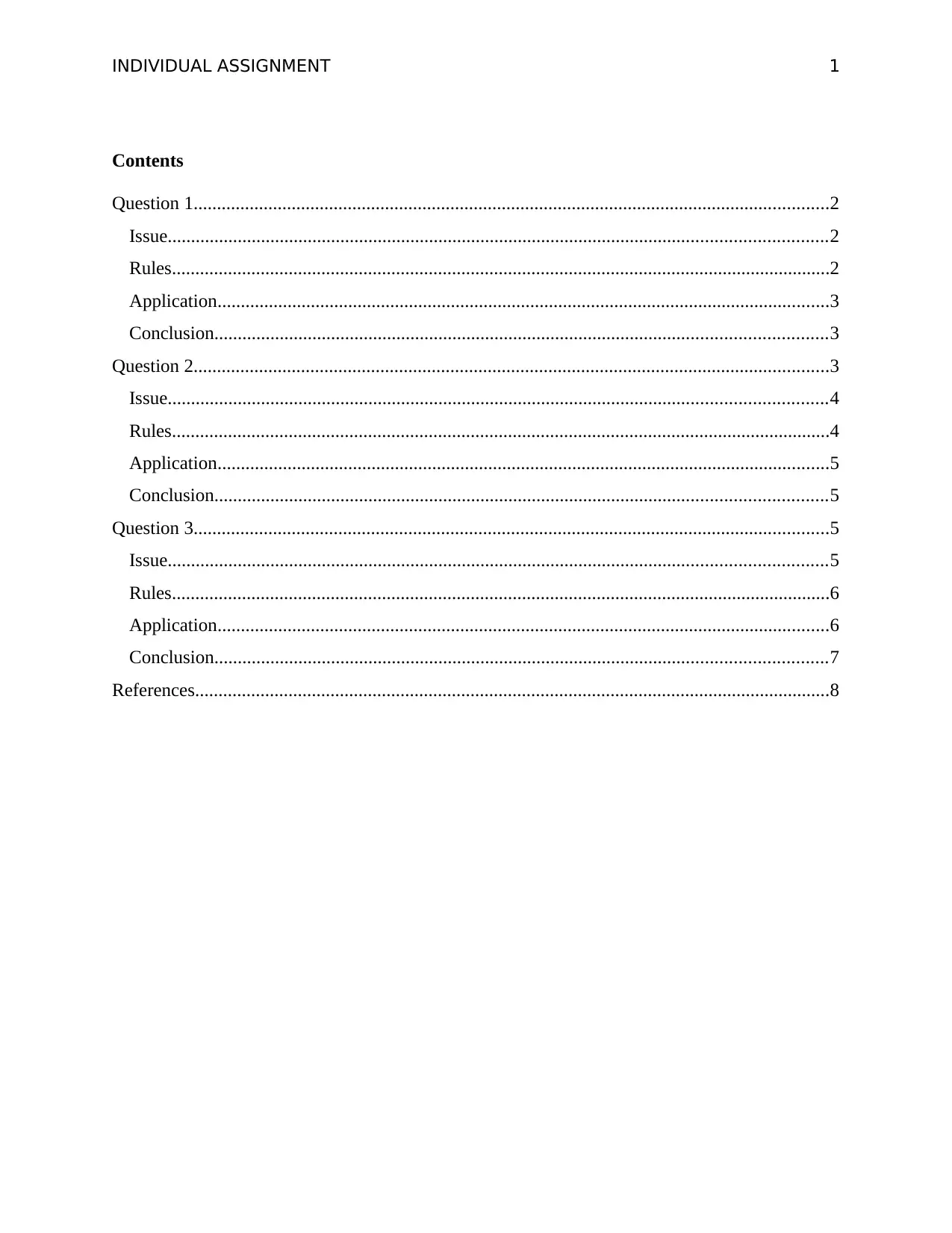
INDIVIDUAL ASSIGNMENT 1
Contents
Question 1........................................................................................................................................2
Issue.............................................................................................................................................2
Rules.............................................................................................................................................2
Application...................................................................................................................................3
Conclusion...................................................................................................................................3
Question 2........................................................................................................................................3
Issue.............................................................................................................................................4
Rules.............................................................................................................................................4
Application...................................................................................................................................5
Conclusion...................................................................................................................................5
Question 3........................................................................................................................................5
Issue.............................................................................................................................................5
Rules.............................................................................................................................................6
Application...................................................................................................................................6
Conclusion...................................................................................................................................7
References........................................................................................................................................8
Contents
Question 1........................................................................................................................................2
Issue.............................................................................................................................................2
Rules.............................................................................................................................................2
Application...................................................................................................................................3
Conclusion...................................................................................................................................3
Question 2........................................................................................................................................3
Issue.............................................................................................................................................4
Rules.............................................................................................................................................4
Application...................................................................................................................................5
Conclusion...................................................................................................................................5
Question 3........................................................................................................................................5
Issue.............................................................................................................................................5
Rules.............................................................................................................................................6
Application...................................................................................................................................6
Conclusion...................................................................................................................................7
References........................................................................................................................................8
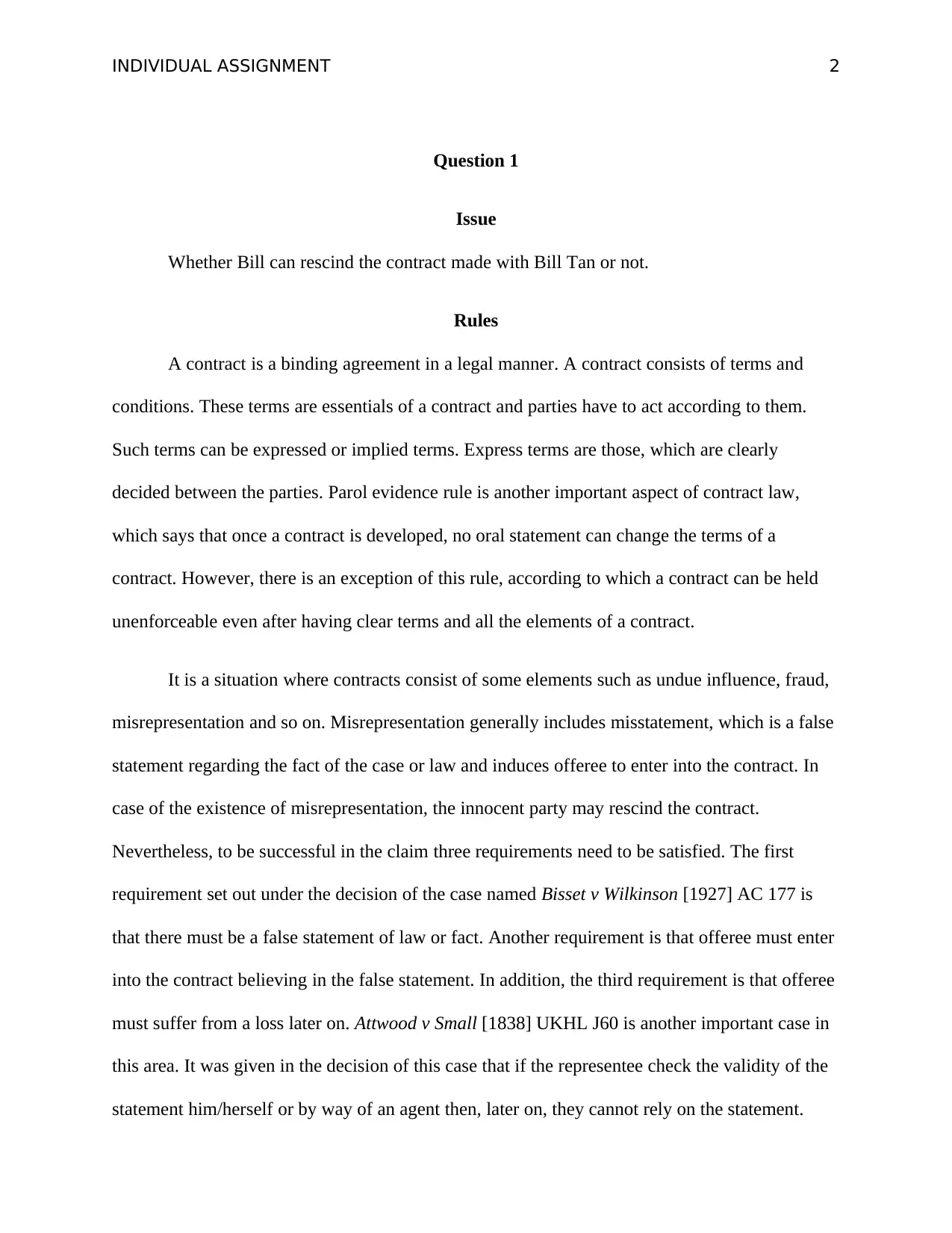
INDIVIDUAL ASSIGNMENT 2
Question 1
Issue
Whether Bill can rescind the contract made with Bill Tan or not.
Rules
A contract is a binding agreement in a legal manner. A contract consists of terms and
conditions. These terms are essentials of a contract and parties have to act according to them.
Such terms can be expressed or implied terms. Express terms are those, which are clearly
decided between the parties. Parol evidence rule is another important aspect of contract law,
which says that once a contract is developed, no oral statement can change the terms of a
contract. However, there is an exception of this rule, according to which a contract can be held
unenforceable even after having clear terms and all the elements of a contract.
It is a situation where contracts consist of some elements such as undue influence, fraud,
misrepresentation and so on. Misrepresentation generally includes misstatement, which is a false
statement regarding the fact of the case or law and induces offeree to enter into the contract. In
case of the existence of misrepresentation, the innocent party may rescind the contract.
Nevertheless, to be successful in the claim three requirements need to be satisfied. The first
requirement set out under the decision of the case named Bisset v Wilkinson [1927] AC 177 is
that there must be a false statement of law or fact. Another requirement is that offeree must enter
into the contract believing in the false statement. In addition, the third requirement is that offeree
must suffer from a loss later on. Attwood v Small [1838] UKHL J60 is another important case in
this area. It was given in the decision of this case that if the representee check the validity of the
statement him/herself or by way of an agent then, later on, they cannot rely on the statement.
Question 1
Issue
Whether Bill can rescind the contract made with Bill Tan or not.
Rules
A contract is a binding agreement in a legal manner. A contract consists of terms and
conditions. These terms are essentials of a contract and parties have to act according to them.
Such terms can be expressed or implied terms. Express terms are those, which are clearly
decided between the parties. Parol evidence rule is another important aspect of contract law,
which says that once a contract is developed, no oral statement can change the terms of a
contract. However, there is an exception of this rule, according to which a contract can be held
unenforceable even after having clear terms and all the elements of a contract.
It is a situation where contracts consist of some elements such as undue influence, fraud,
misrepresentation and so on. Misrepresentation generally includes misstatement, which is a false
statement regarding the fact of the case or law and induces offeree to enter into the contract. In
case of the existence of misrepresentation, the innocent party may rescind the contract.
Nevertheless, to be successful in the claim three requirements need to be satisfied. The first
requirement set out under the decision of the case named Bisset v Wilkinson [1927] AC 177 is
that there must be a false statement of law or fact. Another requirement is that offeree must enter
into the contract believing in the false statement. In addition, the third requirement is that offeree
must suffer from a loss later on. Attwood v Small [1838] UKHL J60 is another important case in
this area. It was given in the decision of this case that if the representee check the validity of the
statement him/herself or by way of an agent then, later on, they cannot rely on the statement.
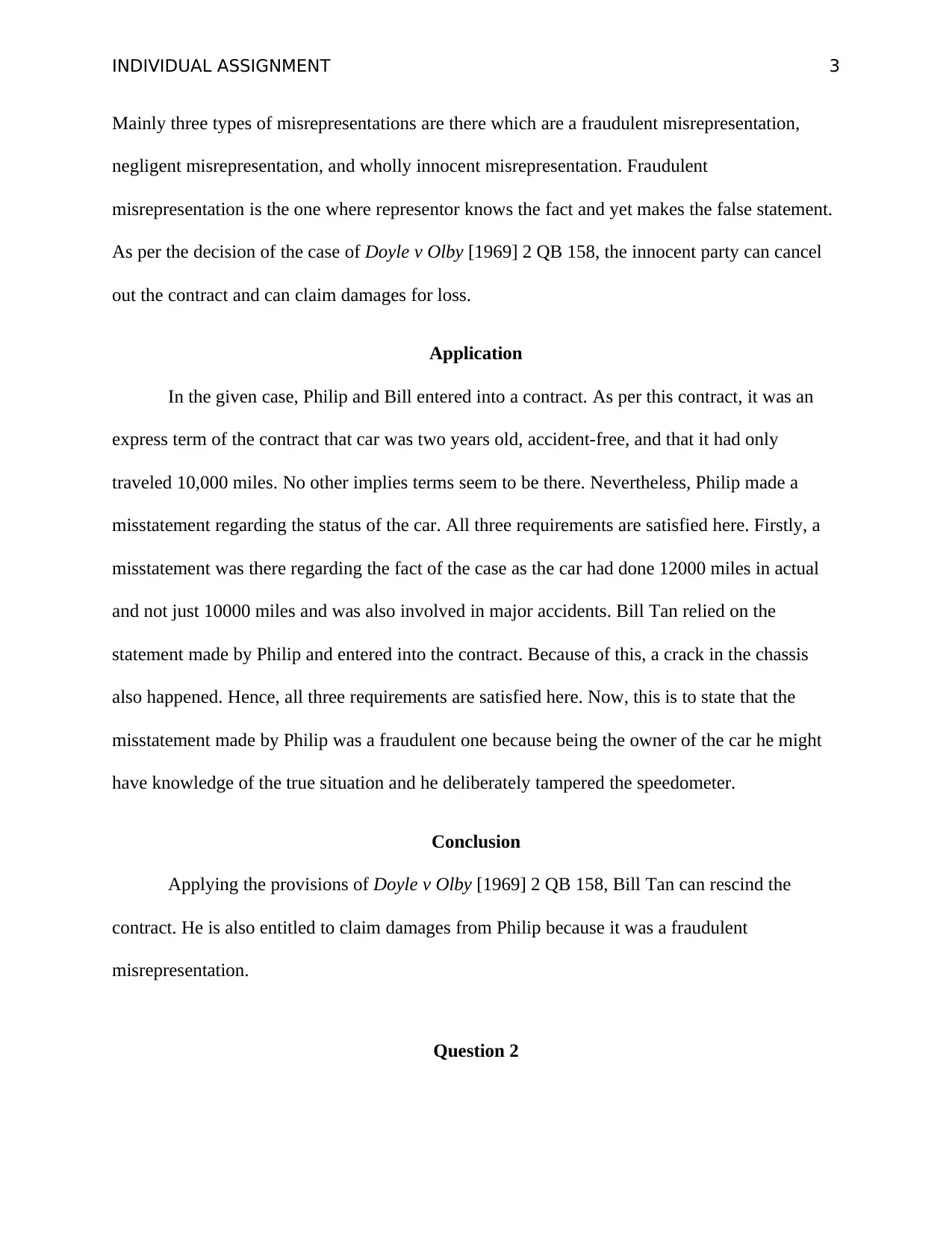
INDIVIDUAL ASSIGNMENT 3
Mainly three types of misrepresentations are there which are a fraudulent misrepresentation,
negligent misrepresentation, and wholly innocent misrepresentation. Fraudulent
misrepresentation is the one where representor knows the fact and yet makes the false statement.
As per the decision of the case of Doyle v Olby [1969] 2 QB 158, the innocent party can cancel
out the contract and can claim damages for loss.
Application
In the given case, Philip and Bill entered into a contract. As per this contract, it was an
express term of the contract that car was two years old, accident-free, and that it had only
traveled 10,000 miles. No other implies terms seem to be there. Nevertheless, Philip made a
misstatement regarding the status of the car. All three requirements are satisfied here. Firstly, a
misstatement was there regarding the fact of the case as the car had done 12000 miles in actual
and not just 10000 miles and was also involved in major accidents. Bill Tan relied on the
statement made by Philip and entered into the contract. Because of this, a crack in the chassis
also happened. Hence, all three requirements are satisfied here. Now, this is to state that the
misstatement made by Philip was a fraudulent one because being the owner of the car he might
have knowledge of the true situation and he deliberately tampered the speedometer.
Conclusion
Applying the provisions of Doyle v Olby [1969] 2 QB 158, Bill Tan can rescind the
contract. He is also entitled to claim damages from Philip because it was a fraudulent
misrepresentation.
Question 2
Mainly three types of misrepresentations are there which are a fraudulent misrepresentation,
negligent misrepresentation, and wholly innocent misrepresentation. Fraudulent
misrepresentation is the one where representor knows the fact and yet makes the false statement.
As per the decision of the case of Doyle v Olby [1969] 2 QB 158, the innocent party can cancel
out the contract and can claim damages for loss.
Application
In the given case, Philip and Bill entered into a contract. As per this contract, it was an
express term of the contract that car was two years old, accident-free, and that it had only
traveled 10,000 miles. No other implies terms seem to be there. Nevertheless, Philip made a
misstatement regarding the status of the car. All three requirements are satisfied here. Firstly, a
misstatement was there regarding the fact of the case as the car had done 12000 miles in actual
and not just 10000 miles and was also involved in major accidents. Bill Tan relied on the
statement made by Philip and entered into the contract. Because of this, a crack in the chassis
also happened. Hence, all three requirements are satisfied here. Now, this is to state that the
misstatement made by Philip was a fraudulent one because being the owner of the car he might
have knowledge of the true situation and he deliberately tampered the speedometer.
Conclusion
Applying the provisions of Doyle v Olby [1969] 2 QB 158, Bill Tan can rescind the
contract. He is also entitled to claim damages from Philip because it was a fraudulent
misrepresentation.
Question 2
Secure Best Marks with AI Grader
Need help grading? Try our AI Grader for instant feedback on your assignments.
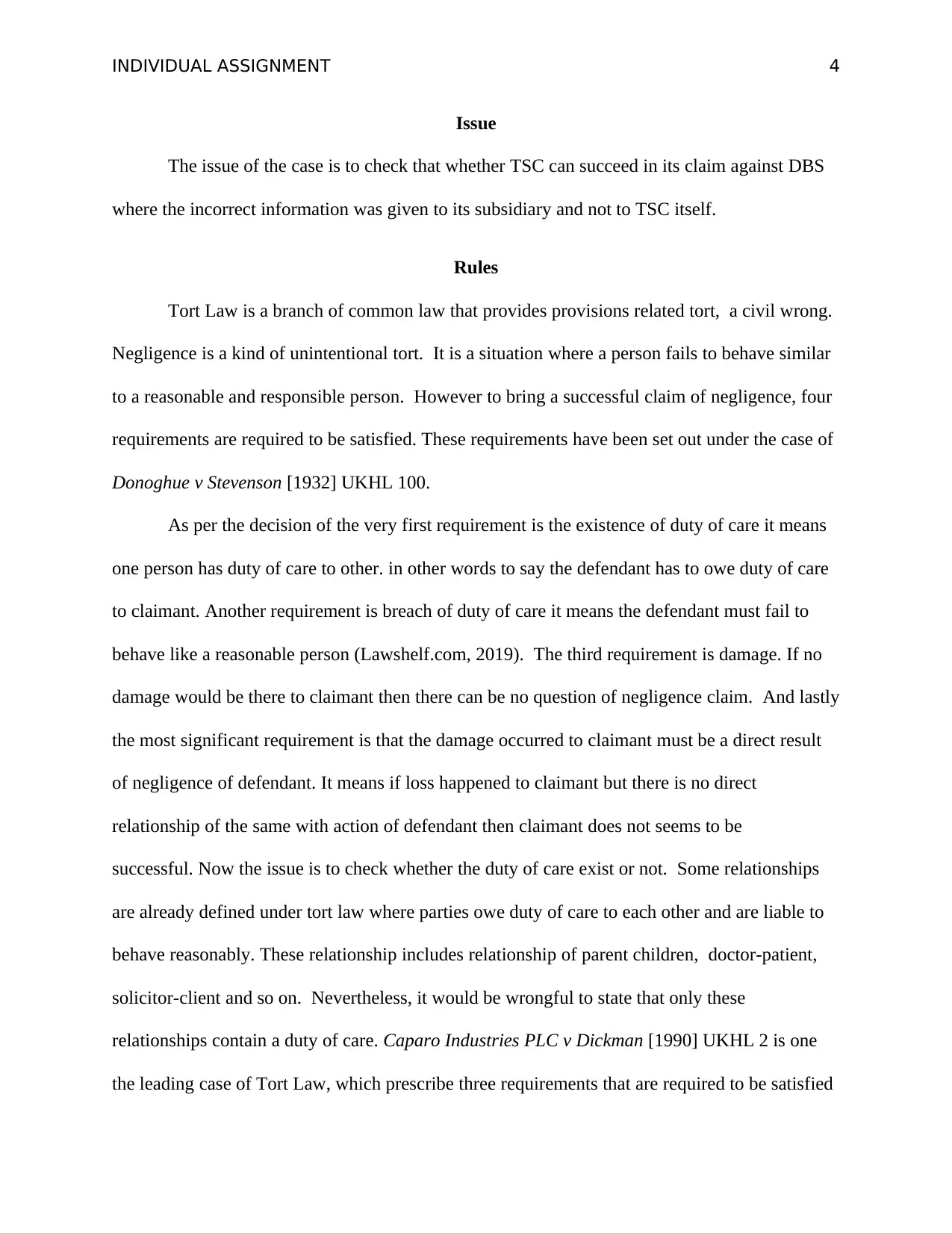
INDIVIDUAL ASSIGNMENT 4
Issue
The issue of the case is to check that whether TSC can succeed in its claim against DBS
where the incorrect information was given to its subsidiary and not to TSC itself.
Rules
Tort Law is a branch of common law that provides provisions related tort, a civil wrong.
Negligence is a kind of unintentional tort. It is a situation where a person fails to behave similar
to a reasonable and responsible person. However to bring a successful claim of negligence, four
requirements are required to be satisfied. These requirements have been set out under the case of
Donoghue v Stevenson [1932] UKHL 100.
As per the decision of the very first requirement is the existence of duty of care it means
one person has duty of care to other. in other words to say the defendant has to owe duty of care
to claimant. Another requirement is breach of duty of care it means the defendant must fail to
behave like a reasonable person (Lawshelf.com, 2019). The third requirement is damage. If no
damage would be there to claimant then there can be no question of negligence claim. And lastly
the most significant requirement is that the damage occurred to claimant must be a direct result
of negligence of defendant. It means if loss happened to claimant but there is no direct
relationship of the same with action of defendant then claimant does not seems to be
successful. Now the issue is to check whether the duty of care exist or not. Some relationships
are already defined under tort law where parties owe duty of care to each other and are liable to
behave reasonably. These relationship includes relationship of parent children, doctor-patient,
solicitor-client and so on. Nevertheless, it would be wrongful to state that only these
relationships contain a duty of care. Caparo Industries PLC v Dickman [1990] UKHL 2 is one
the leading case of Tort Law, which prescribe three requirements that are required to be satisfied
Issue
The issue of the case is to check that whether TSC can succeed in its claim against DBS
where the incorrect information was given to its subsidiary and not to TSC itself.
Rules
Tort Law is a branch of common law that provides provisions related tort, a civil wrong.
Negligence is a kind of unintentional tort. It is a situation where a person fails to behave similar
to a reasonable and responsible person. However to bring a successful claim of negligence, four
requirements are required to be satisfied. These requirements have been set out under the case of
Donoghue v Stevenson [1932] UKHL 100.
As per the decision of the very first requirement is the existence of duty of care it means
one person has duty of care to other. in other words to say the defendant has to owe duty of care
to claimant. Another requirement is breach of duty of care it means the defendant must fail to
behave like a reasonable person (Lawshelf.com, 2019). The third requirement is damage. If no
damage would be there to claimant then there can be no question of negligence claim. And lastly
the most significant requirement is that the damage occurred to claimant must be a direct result
of negligence of defendant. It means if loss happened to claimant but there is no direct
relationship of the same with action of defendant then claimant does not seems to be
successful. Now the issue is to check whether the duty of care exist or not. Some relationships
are already defined under tort law where parties owe duty of care to each other and are liable to
behave reasonably. These relationship includes relationship of parent children, doctor-patient,
solicitor-client and so on. Nevertheless, it would be wrongful to state that only these
relationships contain a duty of care. Caparo Industries PLC v Dickman [1990] UKHL 2 is one
the leading case of Tort Law, which prescribe three requirements that are required to be satisfied
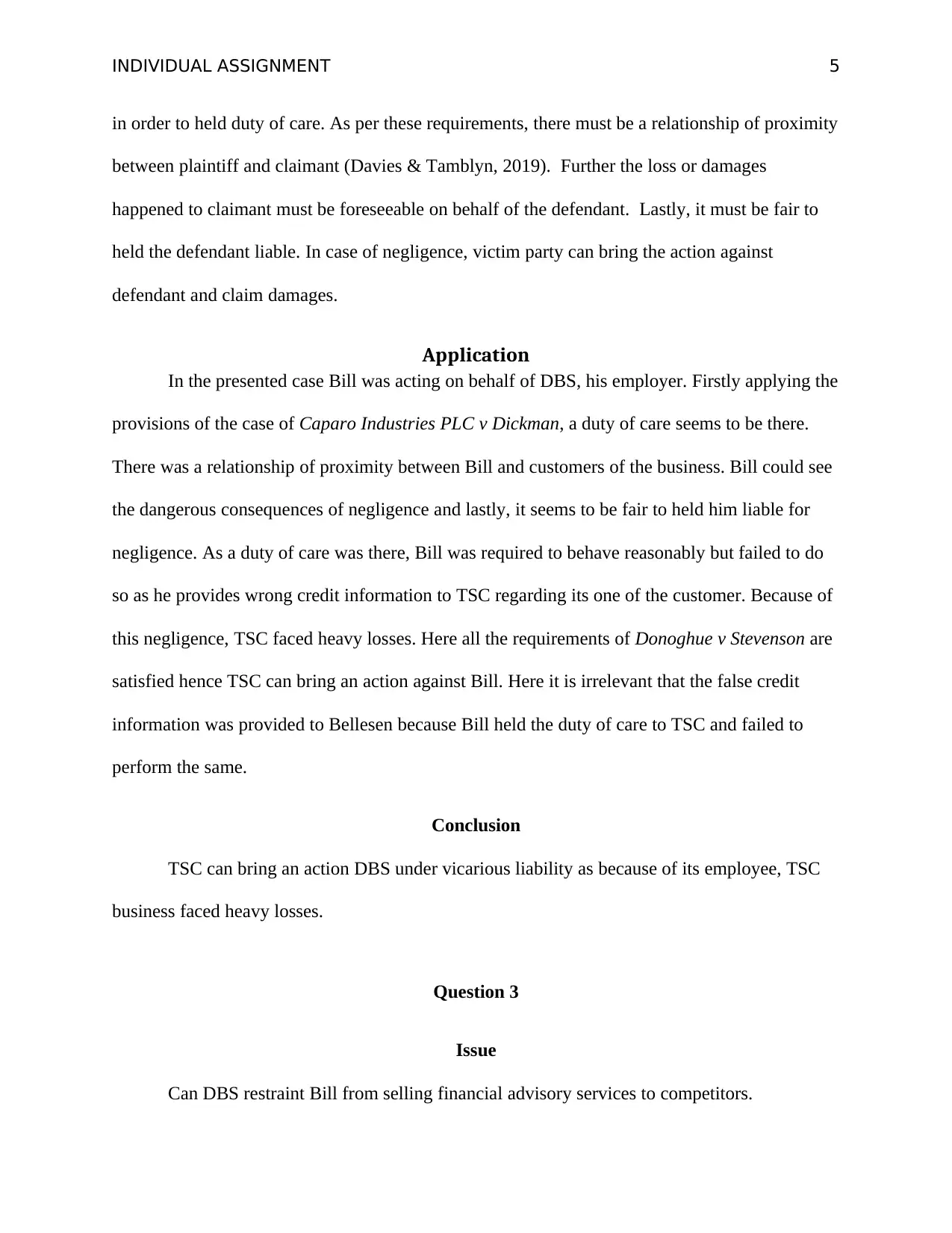
INDIVIDUAL ASSIGNMENT 5
in order to held duty of care. As per these requirements, there must be a relationship of proximity
between plaintiff and claimant (Davies & Tamblyn, 2019). Further the loss or damages
happened to claimant must be foreseeable on behalf of the defendant. Lastly, it must be fair to
held the defendant liable. In case of negligence, victim party can bring the action against
defendant and claim damages.
Application
In the presented case Bill was acting on behalf of DBS, his employer. Firstly applying the
provisions of the case of Caparo Industries PLC v Dickman, a duty of care seems to be there.
There was a relationship of proximity between Bill and customers of the business. Bill could see
the dangerous consequences of negligence and lastly, it seems to be fair to held him liable for
negligence. As a duty of care was there, Bill was required to behave reasonably but failed to do
so as he provides wrong credit information to TSC regarding its one of the customer. Because of
this negligence, TSC faced heavy losses. Here all the requirements of Donoghue v Stevenson are
satisfied hence TSC can bring an action against Bill. Here it is irrelevant that the false credit
information was provided to Bellesen because Bill held the duty of care to TSC and failed to
perform the same.
Conclusion
TSC can bring an action DBS under vicarious liability as because of its employee, TSC
business faced heavy losses.
Question 3
Issue
Can DBS restraint Bill from selling financial advisory services to competitors.
in order to held duty of care. As per these requirements, there must be a relationship of proximity
between plaintiff and claimant (Davies & Tamblyn, 2019). Further the loss or damages
happened to claimant must be foreseeable on behalf of the defendant. Lastly, it must be fair to
held the defendant liable. In case of negligence, victim party can bring the action against
defendant and claim damages.
Application
In the presented case Bill was acting on behalf of DBS, his employer. Firstly applying the
provisions of the case of Caparo Industries PLC v Dickman, a duty of care seems to be there.
There was a relationship of proximity between Bill and customers of the business. Bill could see
the dangerous consequences of negligence and lastly, it seems to be fair to held him liable for
negligence. As a duty of care was there, Bill was required to behave reasonably but failed to do
so as he provides wrong credit information to TSC regarding its one of the customer. Because of
this negligence, TSC faced heavy losses. Here all the requirements of Donoghue v Stevenson are
satisfied hence TSC can bring an action against Bill. Here it is irrelevant that the false credit
information was provided to Bellesen because Bill held the duty of care to TSC and failed to
perform the same.
Conclusion
TSC can bring an action DBS under vicarious liability as because of its employee, TSC
business faced heavy losses.
Question 3
Issue
Can DBS restraint Bill from selling financial advisory services to competitors.
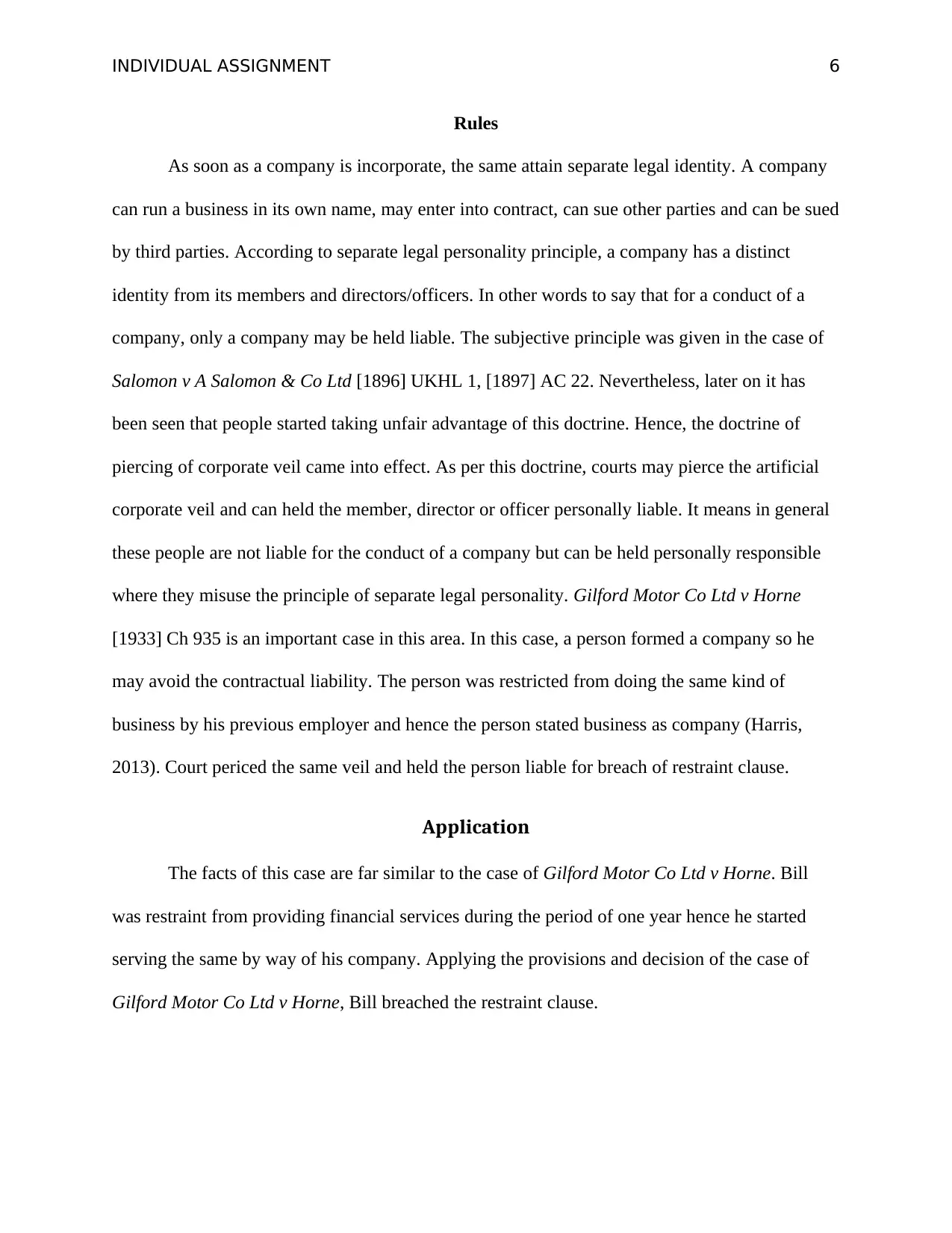
INDIVIDUAL ASSIGNMENT 6
Rules
As soon as a company is incorporate, the same attain separate legal identity. A company
can run a business in its own name, may enter into contract, can sue other parties and can be sued
by third parties. According to separate legal personality principle, a company has a distinct
identity from its members and directors/officers. In other words to say that for a conduct of a
company, only a company may be held liable. The subjective principle was given in the case of
Salomon v A Salomon & Co Ltd [1896] UKHL 1, [1897] AC 22. Nevertheless, later on it has
been seen that people started taking unfair advantage of this doctrine. Hence, the doctrine of
piercing of corporate veil came into effect. As per this doctrine, courts may pierce the artificial
corporate veil and can held the member, director or officer personally liable. It means in general
these people are not liable for the conduct of a company but can be held personally responsible
where they misuse the principle of separate legal personality. Gilford Motor Co Ltd v Horne
[1933] Ch 935 is an important case in this area. In this case, a person formed a company so he
may avoid the contractual liability. The person was restricted from doing the same kind of
business by his previous employer and hence the person stated business as company (Harris,
2013). Court periced the same veil and held the person liable for breach of restraint clause.
Application
The facts of this case are far similar to the case of Gilford Motor Co Ltd v Horne. Bill
was restraint from providing financial services during the period of one year hence he started
serving the same by way of his company. Applying the provisions and decision of the case of
Gilford Motor Co Ltd v Horne, Bill breached the restraint clause.
Rules
As soon as a company is incorporate, the same attain separate legal identity. A company
can run a business in its own name, may enter into contract, can sue other parties and can be sued
by third parties. According to separate legal personality principle, a company has a distinct
identity from its members and directors/officers. In other words to say that for a conduct of a
company, only a company may be held liable. The subjective principle was given in the case of
Salomon v A Salomon & Co Ltd [1896] UKHL 1, [1897] AC 22. Nevertheless, later on it has
been seen that people started taking unfair advantage of this doctrine. Hence, the doctrine of
piercing of corporate veil came into effect. As per this doctrine, courts may pierce the artificial
corporate veil and can held the member, director or officer personally liable. It means in general
these people are not liable for the conduct of a company but can be held personally responsible
where they misuse the principle of separate legal personality. Gilford Motor Co Ltd v Horne
[1933] Ch 935 is an important case in this area. In this case, a person formed a company so he
may avoid the contractual liability. The person was restricted from doing the same kind of
business by his previous employer and hence the person stated business as company (Harris,
2013). Court periced the same veil and held the person liable for breach of restraint clause.
Application
The facts of this case are far similar to the case of Gilford Motor Co Ltd v Horne. Bill
was restraint from providing financial services during the period of one year hence he started
serving the same by way of his company. Applying the provisions and decision of the case of
Gilford Motor Co Ltd v Horne, Bill breached the restraint clause.
Paraphrase This Document
Need a fresh take? Get an instant paraphrase of this document with our AI Paraphraser
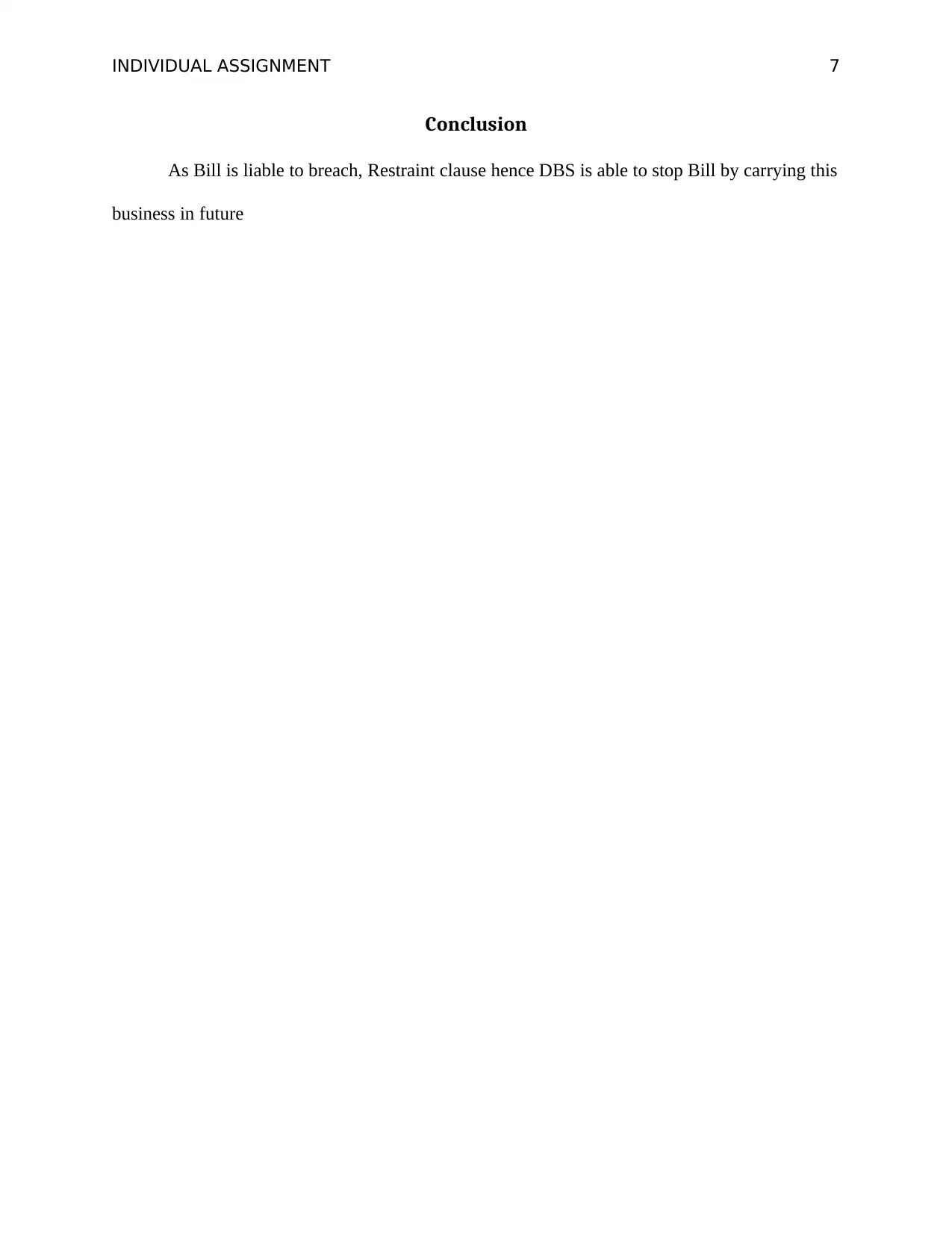
INDIVIDUAL ASSIGNMENT 7
Conclusion
As Bill is liable to breach, Restraint clause hence DBS is able to stop Bill by carrying this
business in future
Conclusion
As Bill is liable to breach, Restraint clause hence DBS is able to stop Bill by carrying this
business in future
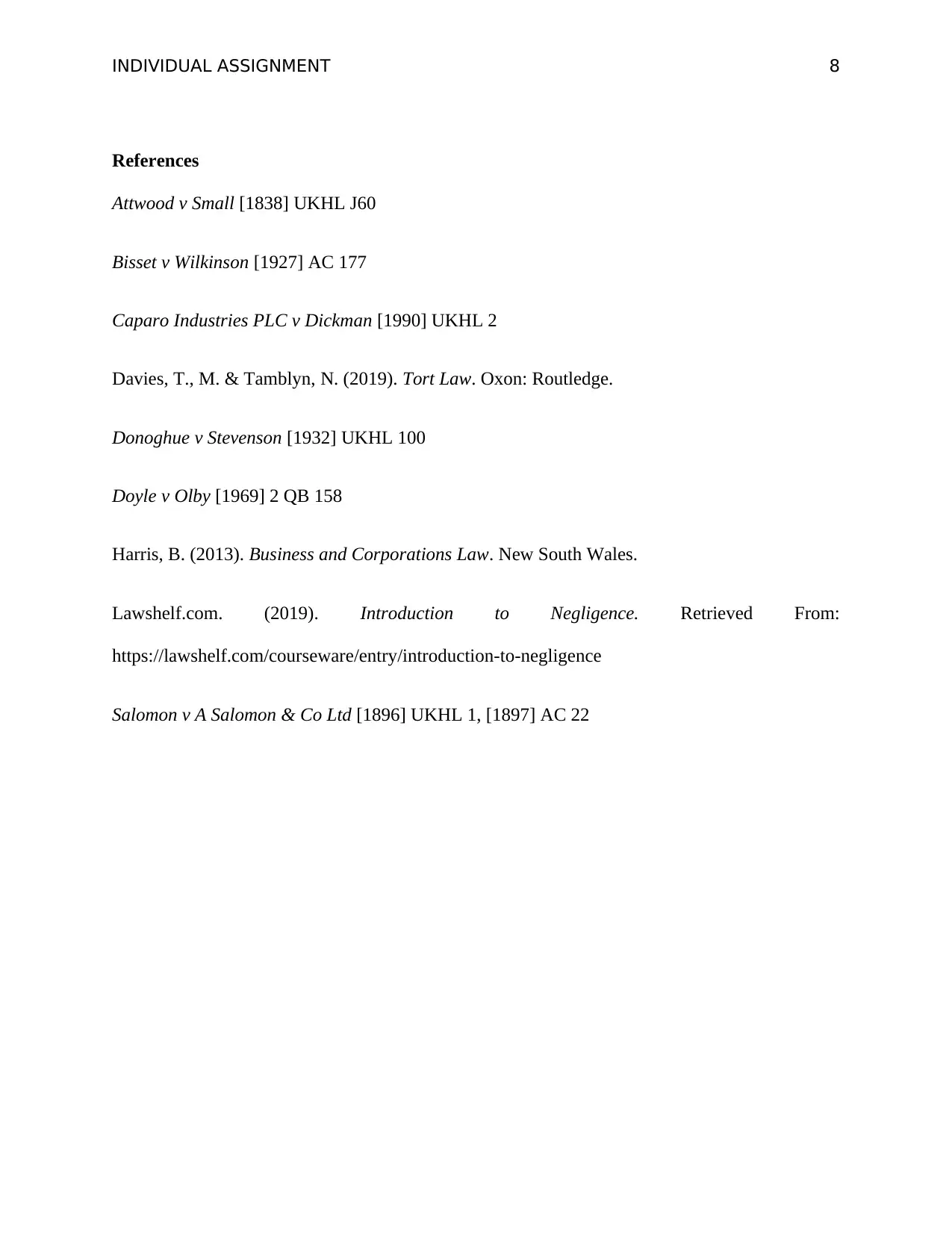
INDIVIDUAL ASSIGNMENT 8
References
Attwood v Small [1838] UKHL J60
Bisset v Wilkinson [1927] AC 177
Caparo Industries PLC v Dickman [1990] UKHL 2
Davies, T., M. & Tamblyn, N. (2019). Tort Law. Oxon: Routledge.
Donoghue v Stevenson [1932] UKHL 100
Doyle v Olby [1969] 2 QB 158
Harris, B. (2013). Business and Corporations Law. New South Wales.
Lawshelf.com. (2019). Introduction to Negligence. Retrieved From:
https://lawshelf.com/courseware/entry/introduction-to-negligence
Salomon v A Salomon & Co Ltd [1896] UKHL 1, [1897] AC 22
References
Attwood v Small [1838] UKHL J60
Bisset v Wilkinson [1927] AC 177
Caparo Industries PLC v Dickman [1990] UKHL 2
Davies, T., M. & Tamblyn, N. (2019). Tort Law. Oxon: Routledge.
Donoghue v Stevenson [1932] UKHL 100
Doyle v Olby [1969] 2 QB 158
Harris, B. (2013). Business and Corporations Law. New South Wales.
Lawshelf.com. (2019). Introduction to Negligence. Retrieved From:
https://lawshelf.com/courseware/entry/introduction-to-negligence
Salomon v A Salomon & Co Ltd [1896] UKHL 1, [1897] AC 22
1 out of 9
Related Documents
Your All-in-One AI-Powered Toolkit for Academic Success.
+13062052269
info@desklib.com
Available 24*7 on WhatsApp / Email
![[object Object]](/_next/static/media/star-bottom.7253800d.svg)
Unlock your academic potential
© 2024 | Zucol Services PVT LTD | All rights reserved.




